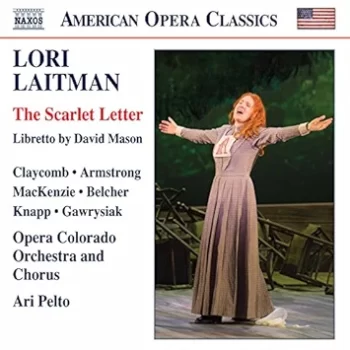2008, rev. 2016 | 3 lead roles for soprano, tenor and baritone; 3 minor roles for mezzo-soprano, tenor and baritone, small chorus (at least 8), non speaking child’s role and chamber orchestra).
Full length opera in 2 Acts, to libretto by poet David Mason based on the Hawthorne classic. Approximately 2 hours long, in 2 Acts (6 scenes). Please see my Opera page and Opera Catalog for more information. There is also a one hour abridged version for 5 voices and piano. Please contact me for more information. And to purchase the Naxos recording please click here.
There are several stand-alone arias, available for PDF download on this site, from my MusicaNeo site. Classical Vocal Reprints also sells hard copies.
- “Beyond All Price” — Hester’s Lullaby (soprano)
- “This Canopy of Trees” — another aria for Hester (soprano)
- “Now Truly Know Me” — Chillingworth’s lament (baritone)
- “Our Nights” — Dimmesdale’s aria (tenor)
- “Ye People of New England” — Dimmesdale’s confession (tenor)
- “Come To The Devil’s Fire” – the Witch’s aria (mezzo-soprano) — The orchestral version is also available. Contact me directly.
- “Our Eden Here is Love” — Hester and Arthur Dimmesdale’s love duet (soprano and tenor duet)
Act I, Scene 2 from the opera (aka “The Prison Scene”) is also available excerpted as a duet for baritone and soprano.
You can purchase the Piano Vocal score from MusicaNeo (link below) or from Classical Vocal Reprints. If you purchased a Piano Vocal Score prior to April 2024, please contact me for a complimentary updated score.
Please note:
The language used to describe Native Americans is taken from the Hawthorne and is not meant to be viewed through today’s lens. It is used to portray the way the Puritans thought of the native population and does not reflect the views that David Mason or I have.
Nevertheless, here are some substitute lyrics:
Act I Scene 1, 268-9: Alternate words for Chillingworth:
Long was my journey/by land and by sea,/my bondage far off/among the natives.
Today this fellow here/has kindly brought me/out of captivity.
Act I Scene 2, 43:
Instead of “Above a year I’ve sojourned with the savages” — the word savages can be changed to “natives here”.
The notes would remain the same but the rhythms would change to 2 8th notes followed by a quarter note on beat 2 for the word “here” (which would remain tied over…).
MUSICAL AND LITERARY SKETCHES from the creation of the work:
MUSICAL SKETCHES:







LITERARY SKETCHES







